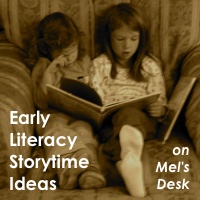It might not seem like wordless books have much to do with getting children ready to read print on a page, but they do! One study found that parents used richer language and more complex sentence structures with their children when talking about a wordless book than they did when sharing a picture book with words, giving their children a little oral language exposure boost.
As A Librarian Less Ordinary says in a recent post, “I actually really enjoy using wordless books for storytime, the kids always impress me with their level of engagement and focus.”
I also liked Erin’s quick comment about recommending wordless books to parents, how they can be successful because parents and children are “both in the same position of deriving meaning from the illustrations.”
Many parents feel less confident choosing and using wordless books, though, so modeling how to “read” one in storytime can be a big help.
You can often find these titles by using “Stories without words” as a search term. Or find a few lists online. Nearly wordless books, such as Goodnight Gorilla by Rathmann or Hug! by Alborough will also work for this activity. Go through the book before storytime and practice “reading” it on your own. Think of a sentence or two to describe each page. Prepare a few open-ended questions about what is going on in the story.
If you’d like, you can introduce the book like this: “Our next book is a little different because it doesn’t have any words for me to read to you. We’re going to have to tell the story ourselves. Will you help me?” I observed a storytime recently from one of our providers, and she pretended to be surprised by the fact that there were no words. She opened the book, and turned a few pages, then said: “Oh my goodness! Miss Elisabeth did something a little silly…she chose a book to read to you that has no words in it! Do you think you can help me read it anyway?”
When you’ve finished your book, say something like this to the adults: “Parents, when you share wordless books with your children, there’s no limit to the conversations you can have together! Taking part in lots of conversations helps your child learn new words, gives them a big vocabulary, and helps them become good readers. Talking with your child will help them get ready to read.”
What are your favorite wordless books to share in storytime? Have you ever made a display of wordless books?



.jpg)
